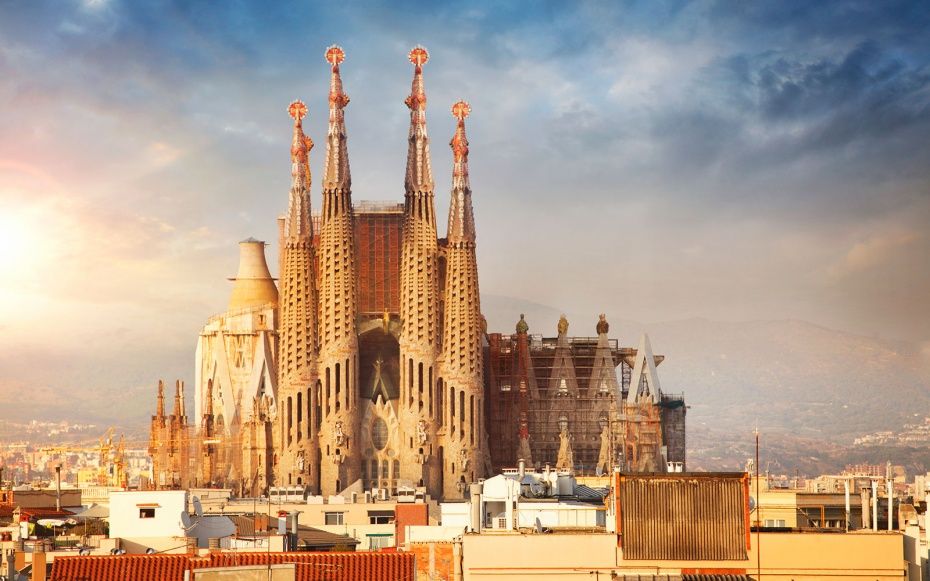Masterpiece Story: Sagrada Familia | DailyArt Magazine
Today’s modern construction techniques allow us to build huge structures in just a few months or years. For example, the Shard in London was built between 2009 and 2012. That was not the case throughout human history, the Egyptian pyramids and medieval cathedrals took generations to complete. Sagrada Familia in Barcelona is a church that reminds us of how it was done in the olden days. Its construction started 140 years ago and, while it is stunning, it is still not completed. Join us to explore its rich history and amazing architecture.
History
The Idea
We are used to the abbreviated name of the church, Sagrada Familia, but the full name is Basílica i Temple Expiatori de la Sagrada Família. The idea for constructing the church came from a bookseller, Josep Maria Bocabella. He was a devout Catholic and the founder of the Spiritual Association of Devotees of Saint Joseph. It was meant to be an expiatory temple, a place made to commemorate the reparation of sins made against God or the laws of the Church. The construction is funded solely from private donations. This uncertain source of funding certainly contributed to the extended timeline.
Early Stages
The first architect was Francisco de Paula del Villar, who created a quite conservative neo-Gothic design in 1882. However, due to disagreements regarding the cost of construction, Villar resigned and Antoni Gaudí took his place in 1883. Gaudí was very religious, and the church was to become his opus magnum. He spent the remainder of his life working on it.
Initially, he combined this with his other commissions, but from 1914 on he devoted his time solely to the church. He even lived on the construction site at some point and created a school for the worker’s children. By the time he died in 1926 only a quarter of it was completed. Only 10 years later, during the Spanish Civil War, the church was vandalized and set on fire. Sadly Gaudí’s designs and architectural models were either damaged or destroyed.
Current State
Recreating the models and designs took 16 years.
Design
Gaudí took the design in a different direction from the original neo-Gothic style proposed by Francisco de Paula del Villar. It is a mix of Catalan Modernism, Spanish Late Gothic, and Art Nouveau. It is a church like no other, as it has also been shaped by its long construction. While every effort is made to reconstruct Gaudí’s original intention, a lot of it is just an educated guess. It is quite easy to recognize which parts were built earlier and later as new construction technology leaves its mark as well.
Plan
The plan for the basilica is probably its most traditional part. Its ground plan has obvious links to earlier Spanish cathedrals such as Burgos Cathedral, León Cathedral, and Seville Cathedral. However, unlike many of these churches, Sagrada Familia was not built on an east-west axis. Instead, it follows a diagonal orientation in line with much of Barcelona’s planning. It places the church on a southeast-northwest axis.
The plan is by no means simple as it includes double aisles, an ambulatory with a chevet of seven apsidal chapels, a multitude of steeples, and three portals. It also has an unusual feature: a covered passage or cloister which forms a rectangle enclosing the church and passing through the narthex of each of its three portals.
Spires
We know that Gaudí originally designed the church with a total of 18 spires.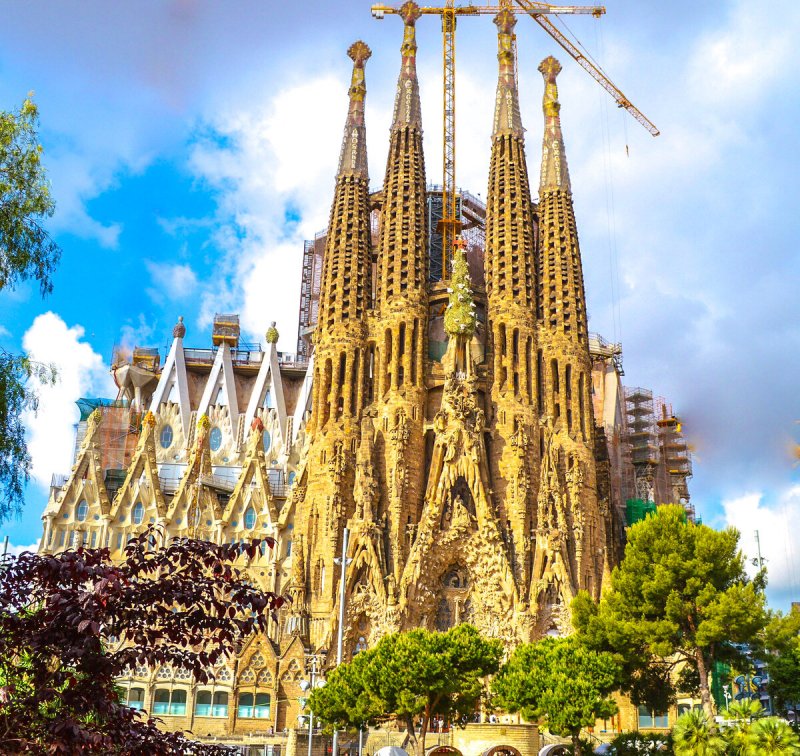
Façades
The Church will have three grand façades: the Nativity façade to the East, the Passion façade to the West, and the Glory façade to the South (yet to be completed). The Nativity façade was built before work was interrupted in 1935 and bears the most direct Gaudí influence.
The Passion façade was built according to the design that Gaudi created in 1917. It is especially striking for its spare, gaunt, tormented characters, including emaciated figures of Christ being scourged at the pillar and Christ on the Cross. These controversial designs are the work of Josep Maria Subirachs.
The Glory façade, which began construction in 2002, will be the largest and most monumental of the three and will represent one’s ascension to God.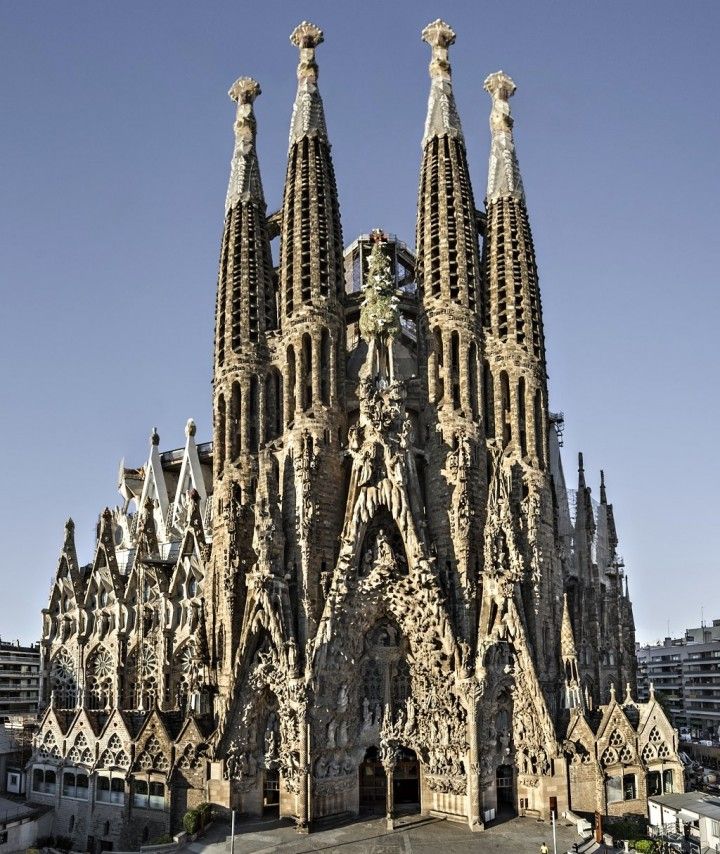
Interior
The interior of Sagrada Familia is even more stunning than its exterior. Gaudí thought of everything, including acoustic studies to ensure the tubular bells he planned for the spires would produce the desired effect. The church plan is that of a Latin cross with five aisles. The columns branch out at the top to better carry the load, but also give an organic tree-like effect. Gaudí also plays with their shape, as it changes with the height of the column.
Essentially no interior surface is flat; the ornamentation is comprehensive and rich, consisting in large part of abstract shapes which combine smooth curves and jagged points. Even detail-level work such as the iron railings for balconies and stairways is full of curvaceous elaboration. All this detail and skillful use of light create an illusion of being within a huge organic structure, rather than one constructed from stone.
Inspirations
Antoni Gaudí stands very much on his own as an architect.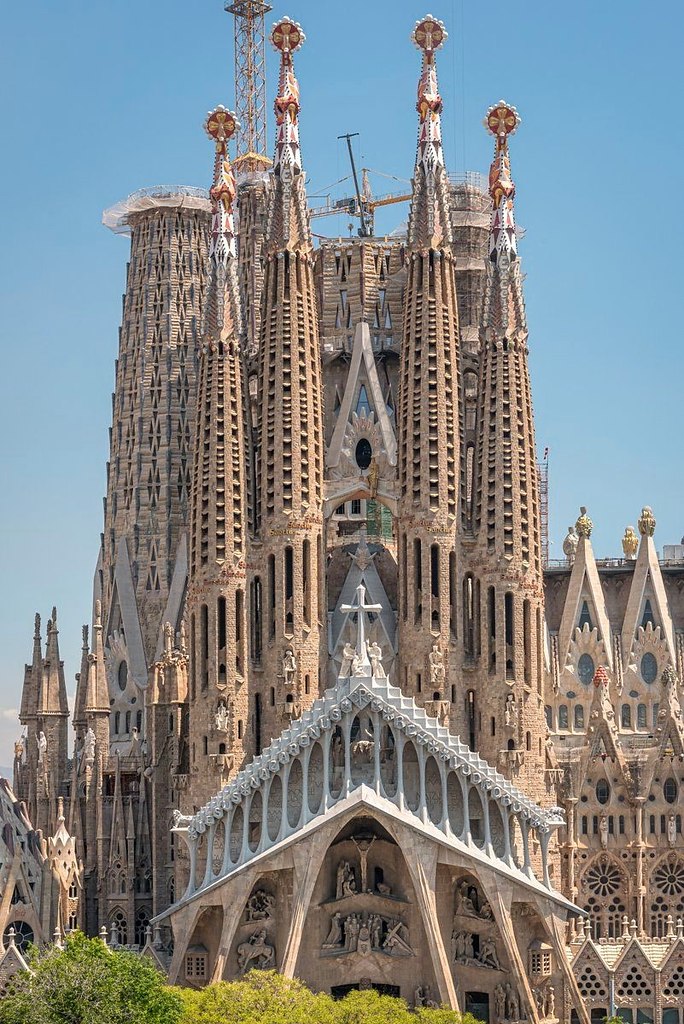
While Gaudí’s design parts way with the neo-Gothic, it keeps the spirit of striving upwards, toward God. In his youth, Gaudí was influenced by John Ruskin‘s analysis of the Gothic, with the praise of its expressive, even grotesque qualities. In this design, Gaudí prioritized the final effect over sticking strictly to one style. Here the form serves the function, and function was defined by the spiritual need.
All parts come together to praise God, celebrate Jesus and his sacrifice, and strike fear into sinners. One of the clearest examples is the façades: the Nativity one softer and joyful, the Passion harsh, striking and evoking fear, and the Glory (still under construction) dazzling us with the power of God.
Gaudí first thought of the impression he wanted to achieve and only then looked for inspiration on how to evoke it.
Gaudí’s Perspective
While Sagrada Familia is a testament to his genius, Gaudí was very aware that the work would be much larger than him. He humbly accepted that he would be one of its many architects.
There is no reason to regret that I cannot finish the church. I will grow old but others will come after me. What must always be conserved is the spirit of the work, but its life has to depend on the generations it is handed down to and with whom it lives and is incarnated.
Antoni Gaudí
In a bit more humorous vein is also observed that his “client is not in a hurry.” As we track the progress of the construction and may be the first generations to see it completed, do you think it was worth the wait?
The Sagrada Familia, a Spanish cathedral still unfinished after 140 years
Christmas is Sunday, but I have an early present for you.
Back in October, my wife and I visited Barcelona — it was supposed to be a 30th anniversary gift to ourselves, but COVID. But after a couple of years, we realized the pandemic is never going away, so we steeled ourselves and flew overseas.
I was vaguely aware that Barcelona is a city in Spain, important during the Spanish Civil War, having read George Orwell’s “Homage to Catalonia.” That’s about it. My wife stepped up, as she always does, and picked what we’d do: at night, eat magnificent tapas dinners at crowded cafes; during the day, visit sites designed by the city’s star architect, Antoni Gaudi.
We picnicked at Park Güell, the rambling high-end housing development turned pleasure compound. We took a night tour of La Pedrera, the curvy apartment building Gaudi designed and lived in, where from the roof we first glimpsed that capstone of our visit, the Basilica de la Sagrada Família, Gaudi’s unfinished masterpiece, an enormous cathedral begun in 1882 and set to be completed in 2026, maybe.
Trying to describe Sagrada Família in words and pictures is something of a fool’s errand. It can’t be conveyed. But given this is Christmas, a season of wonder, with the Three Magi setting out to witness a birth in a manger somewhere in Bethlehem, this seems a time for boldly venturing forth. Were you to go, you’d exit the subway station and first see this mountainous mass — it looks almost organic, a series of pointed conical towers wrapped in protective netting, rising from a mound of mud, with construction cranes jutting out at odd angles.
“Looking for all the world like a cluster of gigantic stone termites’ nests, a colossal vegetable patch,” wrote architectural critic Jonathan Glancey. “A gingerbread house baked by the wickedest witch of all or perhaps a petrified forest.”
Work continues on the Sagrada Familia in Barcelona even while millions of tourists stream through.
Neil Steinberg/Sun-Times
Then you get closer, details emerge, once carved by stonemasons, now by computer-guided milling machines.
This past year — as in most years — so much of politics is driven by people expressing religion in one way or another, often by forcing others to do as they do. Women being barred from schools in Afghanistan and from abortion clinics in the United States. Various groups being harassed because of who they are. That’s one way to manifest faith. Sagrada Familia is another, one that, to me, while not forgiving any excess, at least points to a better way. A world where we can all express our beliefs. Even this.
The first question puzzling me was: How did this happen? How did the church ever approve this phantasmagoria? Or the city of Barcelona, for that matter? I’ve been to enough zoning meetings to know that no way does a 30-year-old architect spread plans of this hallucinogenic vision in 1880 before some Catalonian civic board and get approval.
Which is not what happened. Luck was involved. Construction began in 1882 under guidance of a different architect, Francisco de Paula del Villar, who envisioned a traditional gothic revival church. But he quit the next year, allowing Gaudi to take over and completely redo the project in his own naturalistic, art nouveau vision. Though in places it seems as if you can see outlines of Villar’s ordinary cathedral, peeking out from Gaudi’s carnival in stone.
The nave of Sagrada Familia is 148 feet high, the same as St. Peter’s in Rome. Architect Antoni Gaudi wanted worshippers to feel as if they are in a forest.
Neil Steinberg/Sun-Times
Perceptions of religion not only vary, they change. Nearby is the Barcelona Cathedral, consecrated in 1058. Also enormous and magnificent. But very different from the creation of Gaudi, a pious man whose faith nevertheless was alive with birds and frogs and chickens. His Christianity not only animates man, but nature, and is in turn inspired by it.
Gaudi worked on the basilica for 44 years, focusing on it exclusively for the last dozen. He died in 1926 — hit by a streetcar — and the project almost was scuttled by the Spanish Civil War. In 1936 anarchists broke in, set fire to the crypt, and trashed Gaudi’s studio, destroying his drawings and models, which had to be laboriously pieced back together before construction could resume in the 1950s.
I’m a fan of Orwell, but the tubercular Brit missed the point of Sagrada Família entirely, calling it “one of the most hideous buildings in the world” and rooting for its destruction. (He’s not alone. Go on Yelp, and you have no trouble finding baffled one-star reviews. “A travesty of religion,” writes a Californian. “Waste of time and money. … pretty boring,” adds a North Carolinian. “Was visiting Spain for a few days and came to see this well-known landmark, only to find out that it is not even finished,” complains a tourist from Delaware, who also didn’t like that there were all those cranes ruining his photos.
Gaudi mingled Biblical episodes with barnyard scenes. He felt the natural world is a reflection of divine perfection, and included not only animals in his designs, but also leaves, vines and trees. This influenced Chicago architects, including Louis Sullivan, who called the nascent Sagrada Familia “spirit symbolized in stone.”
Neil Steinberg/Sun-Times
The Sagrada Família is supposed to be completed in 2026, in time for the centennial of the death of Gaudi, who famously retorted to criticisms of the slow pace of construction: “My client is in no hurry.”
COVID tossed a wrench into that, but it is complete enough to hold regular services, and let tourists stream through. Inside is a dizzying space, far simpler, almost devoid of statuary, with soaring fluted columns interrupted by oval lights that give the interior a futuristic feel — Gaudi wants you to feel like you are in a forest.
We went up the Nativity Tower to the roof and got a closeup view of the bunches of fruit, white statuary doves and giant carved seashells.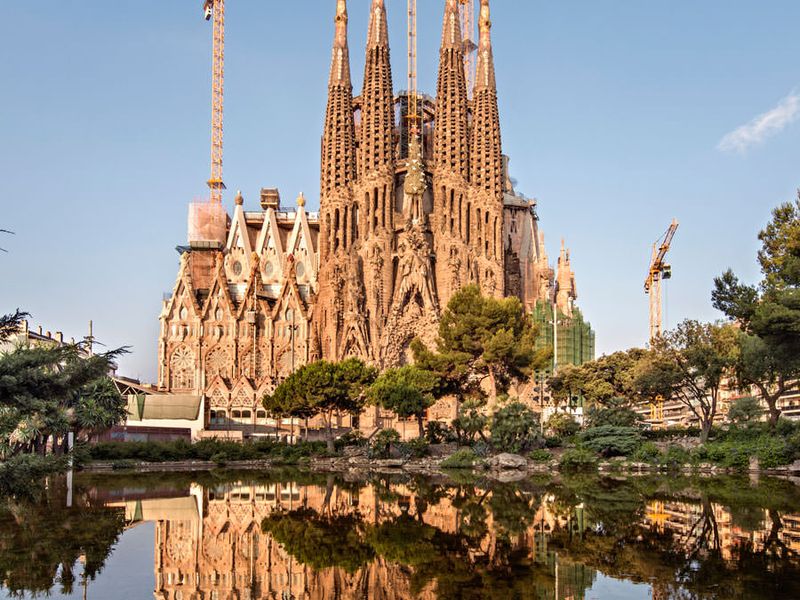
You could spend an hour just studying the great bronze doors, covered with ivy, with rushes, with roses. Hiding within the verdure, all manner of bees, bugs, frogs, salamanders, a nest of baby birds and, elsewhere on the door, a mama bird hurrying to feed them.
The short answer to “How did the church permit this?” is, it didn’t. Sagrada Família was constructed with private funds and not consecrated by the church until Pope Benedict XVI visited in 2010. Readers in the construction trades might smile to learn that a city building permit wasn’t issued until 2019. Sometimes it’s easier not to ask permission.
Which seems a worthwhile point to remember at Christmas. You don’t need approval. We are allowed to believe and celebrate in a fashion guided by our own hearts, to embrace our own visions, wild though they be. Let our minds soar. Freedom is a blessing, though granting the same liberty to others that we enjoy ourselves is clearly a challenge for some. Yet we all manage to live together in a world of wild bounty and disorder, and the only way it works is for us to try to love and respect one another, difficult though that can be.
A model of how the Sagrada Familia will look when finally completed is on display at the cathedral. The sections yet to be constructed are in gold.
Neil Steinberg/Sun-Times
Sagrada Familia – the most significant creation of Gaudi in Barcelona
Night view of the Basilica of the Sagrada Familia and the Glories tower in Barcelona, Catalonia
©
Fundació Junta Constructora del Temple de la Sagrada Família
Barcelona
Barcelona
This temple is on everyone’s lips, because it is one of the most famous works of the great architect Antoni Gaudí, the main representative of the Catalan Art Nouveau, one of the most iconic elements of the urban skyline of Barcelona and one of the most visited monuments of architecture in Spain. This building, striking in its architecture, forms and significance, was inscribed on the UNESCO World Heritage List in 2005.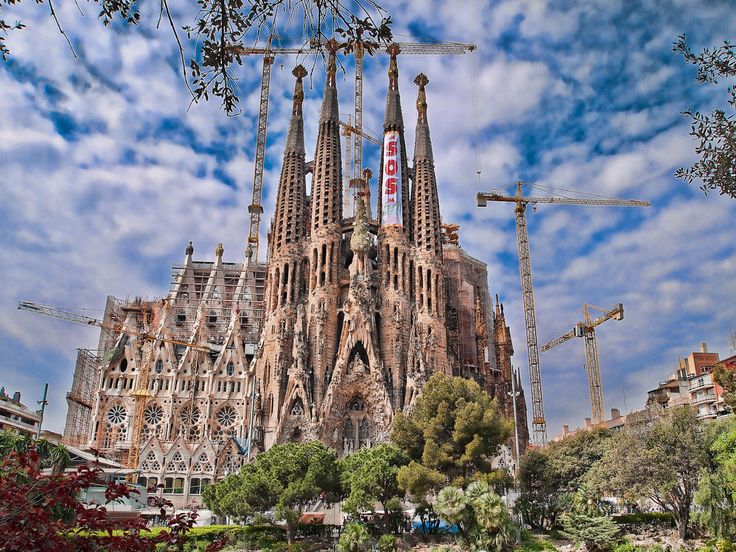
Go to my bookmarks
The foundation stone of this building was laid over 135 years ago, but its construction has not yet been completed. The first plan of the temple was developed in 1882 by Francisco de Paula de Villar, but it did not look like the basilica today. Paula de Villar envisioned a basilica rich in neo-gothic elements, but a year later, due to various obstacles and problems, the architect was removed and the project was handed over to Antoni Gaudí, an up-and-coming architect who radically changed the course of construction.
Night view of Sagrada Familia in Barcelona, Catalonia
©
Fundació Junta Constructora del Temple de la Sagrada Familia
Gaudí endowed the building with his own style and worked on it for most of his life, about 40 years, 15 of which he devoted to this project alone. But the author of this architectural masterpiece himself was able to see the completion of the construction of only some, a few parts of the temple: the crypt, the apse and part of the facade of the Nativity.
Detail of one of the facades of the Basilica of the Sagrada Familia in Barcelona, Catalonia
©
Fundació Junta Constructora del Temple de la Sagrada Familia
Light also plays a huge role in the temple. It not only serves to illuminate, but also creates spaces full of meaning that reveal the ingenious idea of the architect. One notable example is the illumination of the various doors of a building. At the door of the Nativity, the rays of the sun fall at dawn, which means birth, and at the door of the Passion of Christ they fall at sunset, symbolizing death. The facade of Glory is illuminated by the sun all day: the light completely fills the nave, symbolizing the Resurrection.
Nave of the Basilica of the Sagrada Familia in Barcelona, Catalonia
©
Fundació Junta Constructora del Temple de la Sagrada Familia
Find out more about…
Things to do
Ideas to inspire you
Arts and culture
A thousand and one introductions to the Alhambra in pictures
Arts and culture
Images of the Cathedral Mosque in Cordoba
Art and culture
Pictures of the Portico of Glory
Additional information
Sagrada Familia or Sagrada Familia
Home / /
/
/
Mikhail Schwartz
7
The Sagrada Familia was Antonia Gaudí’s main work and life.
Sagrada Familia (Temple Expiatori de la Sagrada Familia)
The pace of construction from 1882 to 1918 was by no means fast. The construction of the temple was conceived not only as an intermediary structure between heaven and sinful earth, but also as a field for the struggle of feelings.
Scheme of the Sagrada Fimilia Cathedral
Scheme of the Sagrada Fimilia Cathedral
History of the creation of the Cathedral
The founder of the Cathedral, José Maria Bocabella, was a bookseller, a Catholic and an extraordinary person. He repeatedly visited Rome and considered the temple of Loreto a model of the church. Bocabella often visited Montserrat and, as legend has it, the idea to build the Sagrada Familia came to him during his stay in the monastery, looking at the image of the Holy Family.
In 1881, the association received a plot of land from the city on the outskirts of the city. Initially, it was planned to build a not very huge temple due to not too large financial resources. During discussions about the future building, the architect Francisco de Paula del Villar y Lozano offered to work on the project free of charge. And a year later, in March, on St. Joseph’s Day, the first stone was laid. At first, the construction was active and successful. But then the relationship between Villar and the church council began to deteriorate and ended in an ugly quarrel. After which it became clear that his further leadership in the construction of the temple was simply unacceptable.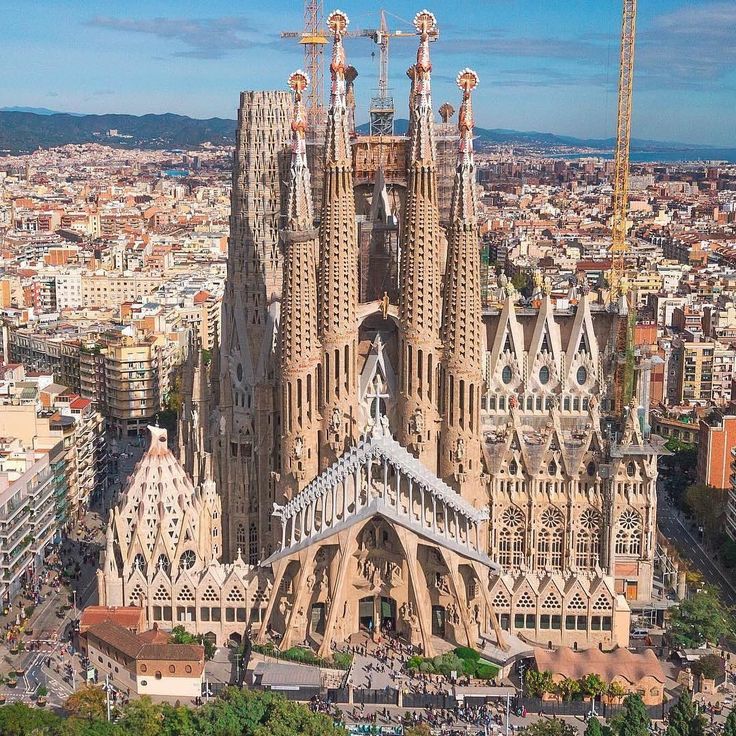
We are in front of the temple
In turn, this order instantly ranked the young 31st architect among the leading architects of Barcelona. Antonio Gaudi created a plaster project, according to which it was planned to build a cathedral 110 meters long and 45 meters high. With four bell towers – according to the number of evangelists and twelve towers – according to the number of apostles. The project included the construction of three facades that told about different episodes of the life of Christ – “Christmas”, “The Passion of Christ” and “Resurrection”.
Elements of the towers
Years passed, workers changed, Antoni Gaudí’s assistants, the construction site became the unofficial faculty of the architecture school. The most zealous students came here in the evenings to listen to the respected Don Antonio. And when the Sagrada Familia finally began to take on a tangible shape, it was so impressive that the fame of the extraordinary idea of the master – the Catalan scattered throughout the earth. To look at it, and at the same time to take part in the grandiose project came from everywhere. King Alfonso came to watch the construction site, with whom Gaudi spoke exclusively in Catalan, which caused discontent of the monarch. Infanta Isabella also visited here. In addition to her, the Sagrada Familia was also visited by Cardinal Ragonesi, Nuncio of the Pope in Spain, Albert Schweitzer.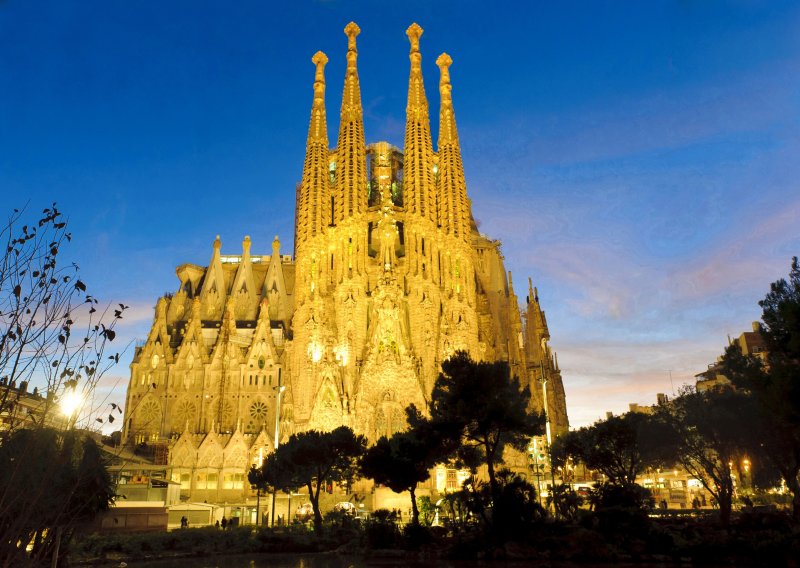
Keys
Construction work either stopped or resumed. Not the last role in stopping the construction was played by financial resources. But even though the Sagrada Familia was the main brainchild of Gaudi, in parallel with it, he carried out other projects. But initially the architect promised to finish the cathedral in 18 years. But, alas, it turned out not to be the case, construction continues to this day.
The difficult wartime made its negative contribution. Architects were losing interest in Gaudí. He himself had to go through a lot: the death of close friends, deteriorating health, mental crisis.
Sagrada Familia was Antonia Gaudí’s main work and life. But from the very beginning, the temple behaved like a demanding host. The Catalan was not only responsible for the design and construction, but also often acted as a fundraiser. The pace of construction from 1882 to 1918 was by no means fast. The construction of the temple was conceived not only as an intermediary structure between heaven and sinful earth, but also as a field for the struggle of feelings.
Gaudí has always focused on natural masterpieces in his projects. So, inside the Sagrada Familia, the vault is supported by very unusual columns resembling the shape of trees.
The interior of the cathedral
Gaudí perfectly understood the psychology of influence and the importance of sound in church buildings. He spent years experimenting with the elongated shape of bells. Because the architect designed the structure so that it could function as a large organ. It was assumed that the wind would pass through the openings of the towers and this would create a real choir. Gaudí’s idea was also to illuminate the highest (170 m.) central tower with floodlights from twelve towers. Then the cross crowning the tower will radiate light, thereby embodying the symbol of the main postulate of Christ: “I am the Light of the World.” But to the greatest regret, this original decision of the master has not yet been translated into reality.
We were photographed a little crookedly
Gaudi himself understood that his life would not be enough to complete his plan.
Today, not only world-famous architects are involved in the construction of the temple, but also every tourist visiting the monument. Because the money he pays for sightseeing goes to the building fund. Thus, the sale of entrance tickets and souvenirs annually brings about 10 million euros to the fund of the temple. Experts have calculated that if things continue like this, the construction of the cathedral could be completed in 2022.
How to get there?
Getting to the Sagrada Fimilia is very easy. The metro station of the same name Sagrada Família is very close, the L5 line passes through it.
Sagrada Familia opening hours:
| from November to February | 09:00 – 18:00 |
| March | 09:00 – 19:00 |
| April to September | 09:00 – 20:00 |
| October | 09:00 – 19:00 |
| 25 and 26 December, 1 and 6 January | 09:00 – 14:00 |
Entrance fees Sagrada Familia
The most complete ticket includes the Cathedral, towers, museum, crypt and audio guide in Russian.

